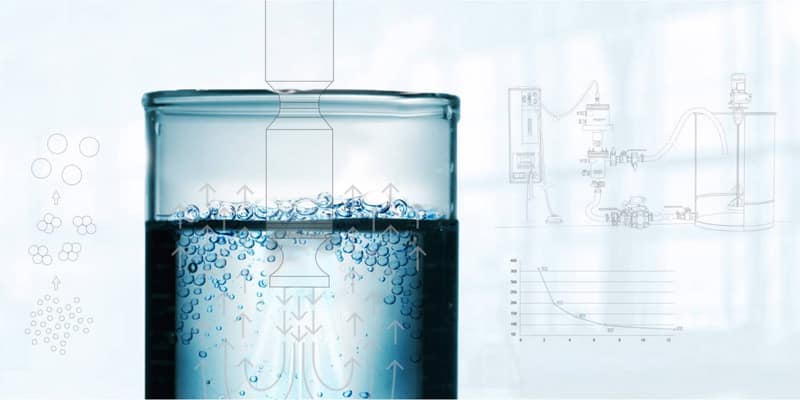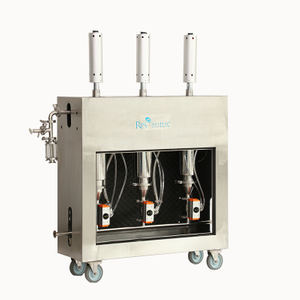Study on The Inactivation of Bacterial Spores by Ultrasonic Technology
Ultrasound is a sound wave with a frequency greater than 20 kHz. It can induce molecular vibrations in liquid media, resulting in destructive physical effects. Due to its green, safe, and pollution-free characteristics, ultrasound is currently widely used in food processing fields such as defoaming, emulsification, extraction, and waste treatment. Lynn et al. discovered that fish exposed to ultrasound in a pool died. Further research revealed the biological effects of ultrasound, leading to studies on its application in sterilization. High-intensity ultrasonic treatment has an inactivating effect on microorganisms and their spores, while simultaneously preserving food quality to the greatest extent possible, representing a transformation direction for traditional heat treatment methods.
Ultrasonic Cavitation Mechanism
When ultrasound propagates in a liquid medium, tiny bubbles (cavitation bubbles) form. Under continuous ultrasonic action, these bubbles accumulate energy and grow. When the energy reaches the cavitation bubble rupture threshold, the cavitation bubble bursts, generating instantaneous high temperature (5500 K) and high pressure (50 MPa), forming the cavitation effect. The cavitation effect is considered the main effect of ultrasound.
There are two different types of cavitation, each with different functions. One type is steady-state cavitation. Under ultrasonic vibration, small bubbles form and undergo symmetrical expansion and inertial compression. The bubble diameter increases, and after thousands of cycles, its size oscillates around its equilibrium size without imploding. The cavitation effect caused by the bubble vibration causes the nearby fluid to rotate, generating micro-beams; this phenomenon is called ultra-micro-beams. The other type is transient cavitation. Under high power (amplitude) conditions, micro-gas nuclei cavitation bubbles existing in the liquid vibrate under the action of ultrasound. During expansion, the pressure is lower than the fluid vapor pressure, causing the bubble to grow larger. During compression, the bubble contracts, and the contents liquefy. Due to the increased bubble area, the contents cannot be completely liquefied back into the fluid; at this point, one cycle is completed. In a certain compression cycle, when the bubble wall resonates with the ultrasound, it can cause the bubble to implode, generating instantaneous high temperature (5500 K) and high pressure (50 MPa), thus producing extremely strong shear forces and inducing turbulence in the region.
Ultrasonic Sterilization Effect
Studies have found that the amplitude, intensity, frequency, exposure time, and treatment temperature of ultrasound all affect its effect on microorganisms, but the range of influence of each parameter is still under investigation. Studies by Soleimanzadeh et al. have shown that high-amplitude ultrasound enhances the disruption of bacterial cell walls and membranes, thus increasing the sterilization effect of ultrasound on Staphylococcus aureus with increasing amplitude. Furthermore, they investigated the effect of the ultrasound duty cycle (the ratio of ultrasound time to interval time) on the sterilization effect, showing that a duty cycle of 7:3 yielded the best sterilization effect, as the cavitation bubbles generated by the probe could more effectively break down, producing a cavitation effect and achieving the best sterilization result. The viscosity, pH value, and type of microorganisms also have some influence on the sterilization effect of ultrasound. Research on the relationship between microbial species and their sensitivity to ultrasound is limited, and various opinions exist without a unified conclusion. Chandrapala et al. believe that the sensitivity of microorganisms to ultrasound is related to cell size and surface structure; bacteria are more sensitive than fungi, anaerobic bacteria are more sensitive than aerobic bacteria, and bacilli are more sensitive than cocci. However, studies by Cameron et al. have shown that the bactericidal effect of ultrasound is not directly related to bacterial size and shape. Comparing Gram-positive and Gram-negative bacteria, Gram-positive bacteria, due to their thicker cell walls and denser peptidoglycan layers, are more resistant to ultrasound, while Gram-negative bacteria are more sensitive to ultrasound treatment.
Many studies have shown that ultrasound has a significant bactericidal effect, although the inactivation of different microorganisms varies in different systems. Ultrasound treatment alone cannot achieve a bactericidal dose of 5 (lg (CFU/mL)). Ultrasound has significant synergistic bactericidal effects with other technologies (such as heat treatment, pressure, heat treatment combined with pressure, UV, nisin, and electrolyzed water).
Research Progress on Ultrasound Combined with Heat Treatment for Spore Inactivation
Although ultrasound treatment alone is not very effective at inactivating spores, it can significantly reduce spore resistance. Therefore, combining it with other bactericidal methods can significantly improve spore inactivation efficiency; for example, ultrasound combined with heat, high pressure, bactericides, and UV treatment all show good results.
Khanal et al. compared the effects of ultrasound and combined ultrasound-heat treatment on the inactivation of *Bacillus cereus* spores. Their results showed that ultrasound not only significantly reduced the resistance of some *Bacillus licheniformis* spores by inducing germination, but also inactivated the spores. Compared to ultrasound treatment alone, combined ultrasound-heat treatment significantly increased the amount of spores inactivated, indicating a synergistic effect between ultrasound and heat treatment on spore inactivation. Evelyn et al.'s research showed that the inactivation of *Clostridium perfringens* spores by ultrasound followed a first-order kinetic model. After 60 min of treatment at 75 ℃ combined with 24 kHz, 0.33 W/g ultrasound, the number of *Clostridium perfringens* spores decreased by 1.5 (lg(CFU/mL)). At this point, the spore inactivation curve was not linear, but it could be well fitted by the Weibull model. Fan Lihua et al.'s research showed that the combined use of ultrasound and heat treatment had a synergistic inactivation effect on spores. Simultaneously, it damaged various spore structures, such as the cortex, spore coat, and spore inner membrane, leading to the release of intracellular substances and thus spore inactivation. Spores of *Bacillus cereus* retained after ultrasonic combined heat treatment could germinate normally, but their later growth was restricted, and they synthesized less or no ATP, indicating that ultrasonic combined heat treatment damaged some key metabolic enzymes during post-germination growth. This is similar to the mechanism of moist heat inactivation of spores. Furthermore, studies have shown that ultrasonic combined heat treatment inactivated *Bacillus cereus* spores in rice porridge, beef paste, and cheese paste by 7, 6, and 4 times, respectively, the amount inactivated by heat treatment alone. Ultrasonic assistance can significantly reduce the intensity of heat treatment alone, reduce energy consumption, and maintain food quality.
Ultrasonic combined technology for food sterilization can largely maintain food quality and reduce the destruction of functional components, showing broad application prospects.


 English
English














